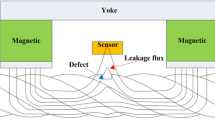Abstract
Nondestructive testing (NDT) has been increasingly applied to wire rope defect detection. In this experiment, in order to obtain better classification effect of wire rope defects, a broken wire identification method that fuses the magnetic flux leakage (MFL) signal, thermal infrared signal and visible light signal is proposed. The MFL signal is processed by the sliding mean filtering and the MFL signal denoising algorithm based on Complete Ensemble Empirical Mode Decomposition with Adaptive Noise (CEEMDAN) to remove the baseline and high frequency noise from the MFL signal. A infrared image defect extraction method based on wire rope strand structure is proposed. Morphological processing of visible images is performed to extract visible defect images and applying the gamma transform enhances them. Features are extracted from the three kinds of defect images and feature fusion is performed. A Self-Organizing Feature Map (SOFM) network is employed for quantitative identification of broken wires. Experiment results show that the fusion of three kinds of defect images features can further improve the recognition effect of broken wires.


















Similar content being viewed by others
REFERENCES
Prawoto, Y. and Mazlan, R.B., Wire ropes: Computational, mechanical, and metallurgical properties under tension loading, Comput. Mater. Sci., 2012, vol. 56, pp. 174–178.
Basak, D., Performance evaluation of an independent wire rope core in a cage winder of a mechanized coal mine using nondestructive testing instrument, J. Min. Sci., 2013, vol. 49, no. 4, pp. 625–629.
Peng, P.C. and Wang, C.Y., Use of gamma rays in the inspection of steel wire ropes in suspension bridges, NDT & E Int., 2015, vol. 75, pp. 80–86.
Rostami, J., Tse, P.W., Yuan, M., Detection of broken wires in elevator wire ropes with ultrasonic guided waves and tone burst wavelet, Struct. Health Monit., 2020, vol. 19, no. 2, pp. 481–494.
Zhou, Z. and Liu, Z., Detecting and Locating Local Flaws Based on Magnetic Flux Leakage Imaging for Wire Ropes, Prognostics Syst. Health Manage. Conf. (Chongqing, 2018).
Cho, H.M., Cho, H.S., Kim, K.S., et al., Experimental study on the application of a compressed sensing (based deblurring method in x ray nondestructive testing and its image performance, NDT & E Int., 2015, vol. 75, pp. 1–7. https://doi.org/10.1016/j.ndteint.2015.06.001
Cao, Q., Dan, L., He, Y., et al., Nondestructive and quantitative evaluation of wire rope based on radial basis function neural network using eddy current inspection, NDT & E Int., 2012, vol. 46, no. 7, p. 13.
Martins, J.O. and Robitaille, F., Nondestructive infrared inspection of dry multilayer carbon fibre preforms, J. Textile Inst., 2018, vol. 109, no. 4, pp. 501–516.
Wang, Z.Q., The detection system for elevator wire rope based on image processing, Microcomput. Inf., 2011.
Lin, W. and Liu, L.J., Nondestructive testing of ship steel wire rope based on electromagnetic principle, 6th Int. Conf. Inform. Sci. Control Eng. (Shanghai, 2019).
Chai, X., Lu, Y., and Gan, Z., Structure and character analysis of a new type of steel wire rope NDT detector apparatus, 2009 Int. Conf. Mechatronics Autom. (Chengdu, 2009).
Sharatchandra, S.W., Sagar, K.S.V., Mukhopadhyay, C.K., et al., Modeling and experimental studies on 3d-magnetic flux leakage testing for enhanced flaw detection in carbon steel plates, Res. Nondestr. Eval., 2018, pp. 1–16.
Kim, J.W. and Park, S., Magnetic flux leakage sensing and artificial neural network pattern recognition–based automated damage detection and quantification for wire rope non-destructive evaluation, Sensors, 2018, vol. 18, no. 2, p. 109.
Lv, J. and Liu, G., Noise reduction in magneto-acousto-electrical NDT using analytic wavelet thresholding, Inform. Technol. Mechatronics Eng. Conf. (Chongqing, 2017).
Zhang, J., Zheng, P., and Tan, X., Recognition of broken wire rope based on remanence using EEMD and wavelet methods, Sensors, 2018, vol. 18, no. 4, p. 1110.
Zhou, Z. and Liu, Z., Fault diagnosis of steel wire ropes based on magnetic flux leakage imaging under strong shaking and strand noises, IEEE Trans. Ind. Electron., 2020, vol. 68, pp. 2543–2553. https://doi.org/10.1109/TIE.2020.2973874
Liu, S., Sun, Y., Ma, W., et al., A new signal processing method based on notch filtering and wavelet denoising in wire rope inspection, J. Nondestr. Eval., 2019, vol. 38, no. 2.
Yang, L., Shi, M., and Gao, S., The method of the pipeline magnetic flux leakage detection image formation based on the artificial intelligence, Int. Conf. Vid. Image Process. (Singapore, 2017).
Gao, X., Lan, C., You, D., et al., Weldment nondestructive testing using magneto–optical imaging induced by alternating magnetic field, J. Nondestr. Eval., 2017, vol. 36, no. 3, p. 55.
Zhou, J. and Wang, D., Quantitative inspection for identifying broken coal mine wire rope based on wavelet packet sparse representation, Insight, 2021, vol. 63, no. 2, pp. 102–110.
Zhang, G. and Tang, Z., Convolutional autoencoder based flaw detection for steel wire ropes, Sensors, 2020, vol. 20, no. 22.
Wang, Z. and Yu, Y., Traditional eddy current—Pulsed eddy current fusion diagnostic technique for multiple micro–cracks in metals, Sensors, 2018, vol. 18, no. 9.
Li, X., Zhang, J., and Shi, J., Quantitative nondestructive testing of broken wires for wire rope based on magnetic and infrared information, J. Sensors, 2020, vol. 2020, no. 3, pp. 1–14.
Jing, J., Dong, L., et al., A multi–source information fusion approach for crack detection of 42CrMo steel during fatigue test, 2016 IEEE Far East NDT New Technol. Appl. Forum (Nanchang, 2016).
Yue, D., Peng, C., Du, D., et al., Research on fault data wavelet threshold denoising method based on CEEMDAN, Int. Conf. Life Syst. Model. Simul., 2017, pp. 75–83.
Funding
This work was partially supported by National Natural Science Foundation of China (Grant no. U2004163).
Author information
Authors and Affiliations
Corresponding author
Ethics declarations
The authors declare that they have no conflicts of interest.
Rights and permissions
About this article
Cite this article
Zhang, Z., Zhang, J. Quantitative Nondestructive Testing of Broken Wires for Wire Rope Based on Multi-Image Fusion. Russ J Nondestruct Test 58, 643–656 (2022). https://doi.org/10.1134/S1061830922070117
Received:
Revised:
Accepted:
Published:
Issue Date:
DOI: https://doi.org/10.1134/S1061830922070117




